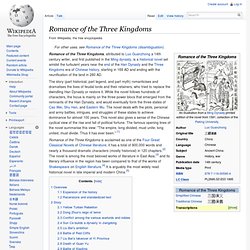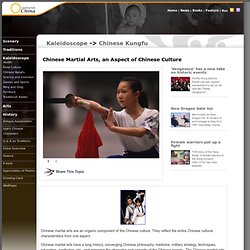

Sun Tzu's Art of War - Chapter 8: Variation in Tactics. Confucius and bravery. Confucianism. Romance of the Three Kingdoms. Romance of the Three Kingdoms, attributed to Luo Guanzhong a 14th century writer, and first published in the Ming dynasty, is a historical novel set amidst the turbulent years near the end of the Han Dynasty and the Three Kingdoms era of Chinese history, starting in 169 AD and ending with the reunification of the land in 280 AD.

The story (part historical, part legend, and part myth) romanticises and dramatises the lives of feudal lords and their retainers, who tried to replace the dwindling Han Dynasty or restore it. Cao Cao evolving from sinner to saint. Jing Ke. Background[edit] In exchange for peace, King Xi of Yan had earlier forced his son Crown Prince Dan of Yan to be held hostage by the Qin, but Prince Dan returned knowing that Qin was far stronger than Yan and would attack it later.[2] Jing Ke originally came from the State of Wey (衞).

He was a scholar, proficient in the art of the sword. His homeland of Wei was absorbed by Qin, and Jing Ke fled to Yan.[2][2] A Youxia named Tian Guang (田光) first introduced him to Prince Dan.[3] There Jing Ke accepted the hospitality of Prince Dan, who as a last resort decided to send an assassin against the King of Qin.[2] The plan involved either kidnapping the king and forcing him to release the territories from his control; or failing this, killing him.[2] The expectation in either case was that Qin would be left disorganized, enabling the other six major states to unite against it.[2] Assassination attempt[edit] Planning[edit] Assassination Attempt[edit] Yan annihilation[edit] Cultural references[edit] Chinese Martial Arts, an Aspect of Chinese Culture - China culture. Chinese martial arts are an organic component of the Chinese culture.

They reflect the entire Chinese cultural characteristics from one aspect. Chinese martial arts have a long history, converging Chinese philosophy, medicine, military strategy, techniques, education, aesthetics, etc., and mirroring the character and sagacity of the Chinese people . The Chinese martial arts pay great attention to mental activities in fighting.
Ten Famous Swords in China's Ancient Times. Learning from Lin Hao. Yao Ming with Lin Hao during the Olympics opening ceremony.

(Photo by Cameron Spencer/Getty Images) When Chinese flag bearer and basketball phenom Yao Ming walked through the National Stadium during the opening ceremony of the Olympics, there was so much commotion where I was that I neglected to find out more about the little boy was that he was walking with. It was Lin Hao, a nine-year-old who survived the deadly earthquake in Sichuan in May. It's interesting how this tribute to the earthquake by opening ceremony director Zhang Yimou has been covered by the international press.
Many Western news outlets reported that Lin was an earthquake survivor, but they failed to mention that the little boy, who was attending the Yuzixi Primary School in quake-epicenter-Wenchuan County, not only survived, but after getting out of his classroom, went back into the rubble to pull two classmates out to safety. During his rescue, he was hit by falling rubble and suffered injuries on his head and arms. Legend of Mulan - Chinese Culture. Guest Author - Caroline Baker Disney made her famous with a feature movie.

But who is this brave Chinese warrior woman? The story of Mulan is traced back to a poem told during the Tang Dynasty, around 600 AD. Over the years, that poem has changed and grew, much like the poetry of Homer and his Odyssey and Illiad. The story was past from mother to her children. Mulan has also gone by the name Fa Mu Lan, or Hua Mu Lan. There are several different versions of this story.